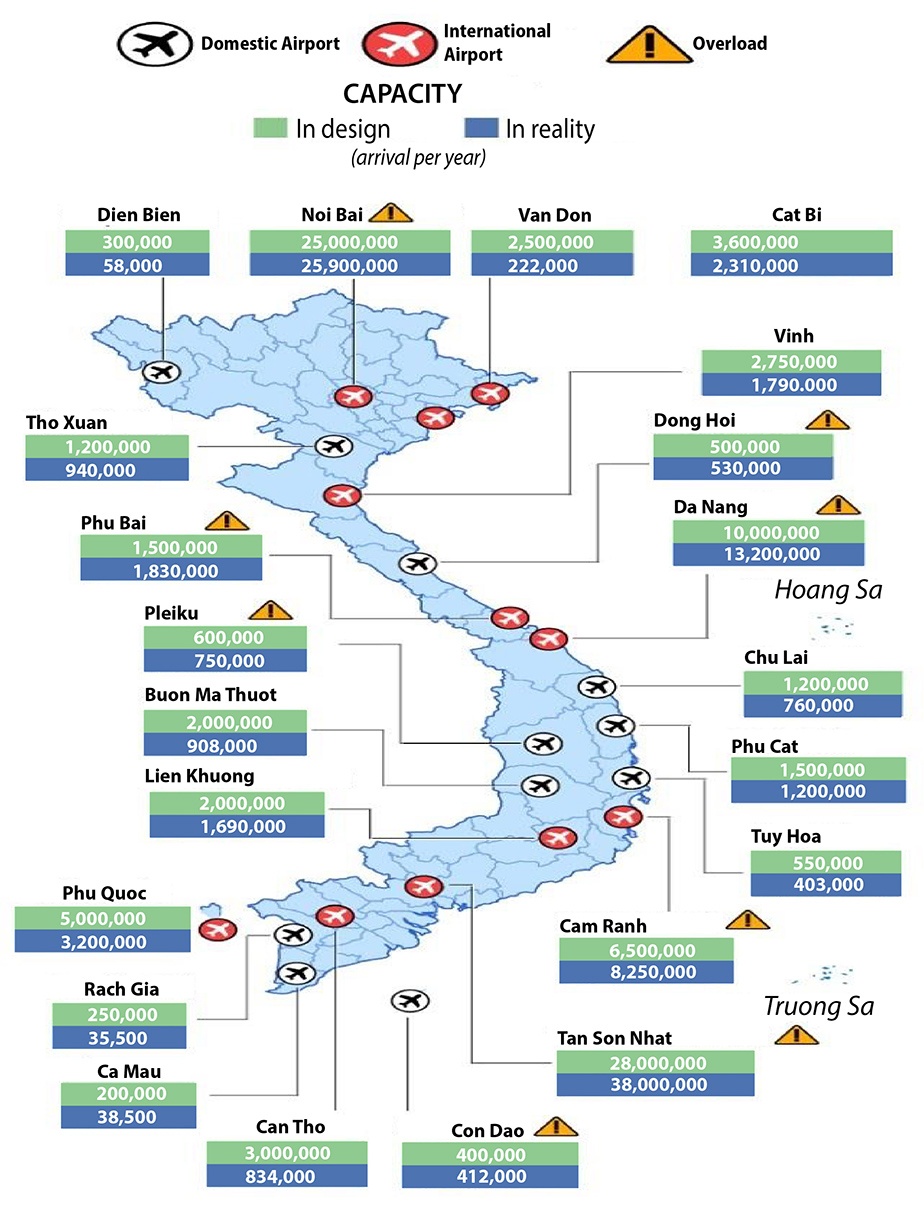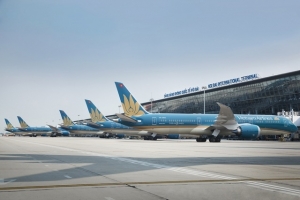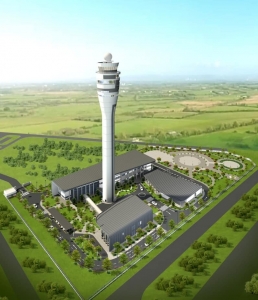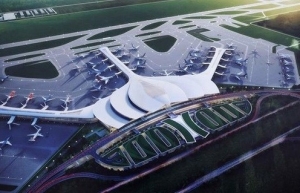Linking the skies with upgraded aviation infrastructure
 |
| New airport infrastructure is considered a must for local economic growth |
Of the 22 airports operating around the nation, only Van Don International Airport is privately owned and managed. In order to fully exploit the benefits of Vietnam's rich and attractive natural environment, developing and constructing new airport infrastructure is a crucial link.
Phu Quoc is representative of the aviation industry's contribution to the local economy. Before being the first island city in Vietnam to grow with the aim of becoming Asia's premier economic and tourist hub, this location was an impoverished island district. Despite its proximity to several nations in the area and its advantageous position, the island has not prospered much via marine trade alone.
According to Phu Quoc People's Committee, around 300,000 people visited the district in 2010. In 2014, almost two years after Phu Quoc International Airport began operations, the island received over 600,000 tourists, including 125,000 international visitors, a 21.5 per cent increase over the same time period.
Phu Quoc's tourist earnings surpassed $92 million, surpassing 11 per cent of the goal and growing over 84 per cent from that of 2013. The ambition of receiving 7.8 million tourists and generating an income that is 2.3 times that of the previous year was not that far off.
Since the airport opened in 2012, the island has been constantly upgrading, luring large investors to operate and establish, and transforming the island's hidden and unspoiled beauty into a leading tourist destination in the region, ousting Bali and Phuket to host the wedding of an Indian billionaire.
In addition, there are other prospective tourist locations in Vietnam like Phu Quoc, particularly in mountainous regions like the northwest and the Central Highlands. These are all locations where several tourist attractions intersect.
However, due to the complex terrain, commerce with highland provinces like Son La, Dien Bien, Kon Tum, and Dak Nong still faces several challenges.
 |
Following international examples of advantageous infrastructure
In 1983, Turkey passed a law permitting private enterprises to handle airport and aviation services. The act opened the door to the aviation industry's prosperity.
According to the General Directorate of the State Airports Authority of Turkey (DHMI), the number of travellers in Turkey reached 45 million in 2004, a 30.7 per cent rise compared to the previous year, and the growth rate exceeded 23.3 per cent in 2005, reaching 55.5 million passengers.
According to DHMI 2005, the aviation sector produced 80,000 jobs and generated $300 million in income for ground service firms.
In 2004, 71.7 per cent of the total 17.5 million tourists to Turkey arrived by air, doubling the industry's earnings. In 2018, the aviation sector contributed $44.8 billion to Turkey's gross domestic product.
With the vital function of aviation infrastructure, Turkey intends to construct new airports at many crucial places in tourism and transportation to enhance income, raising the annual number of international travellers to Turkey to 202 million.
Elsewhere, France benefited from the aviation sector by constructing major airports not only in the capital and major cities but also in unique topographic areas. The International Air Transport Association (IATA) estimates that the air transport sector, including airlines and their supply chains, contributes $87 billion to the economy.
France has five domestic and international airports, including Geneva, Grenoble-Isère, Annecy Haute-Savoie, Lyon Saint Exupéry, and Chambéry Savoie Mont Blanc, that assist in linking travellers from across the globe to this renowned mountain range.
According to Vinci Airports, the Chambéry Savoie Mont Blanc airport, which operates largely charter flights during the winter months and is busiest on weekends, received around 200,000 skiers in 2018.
Thanks to its excellent location, which minimises time compared to commuting by rail (about nine hours from London) or bus (20 hours), passing via Chambéry airport only takes more than one hour, hence contributing to a growth in British and Russian passenger numbers.
The Alps, famed for their gorgeous and upscale ski resorts such as Meribel, Courchevel, Tignes, and Val d'Isere, are the most obvious example. Every year, these premium resorts draw hundreds of thousands to millions of tourists and professionals.
In addition to examples such as Turkey and France, IATA figures from June 2022 indicate that aviation carries almost two billion people annually and accounts for 40 per cent of interregional export transactions (by value).
This demonstrates that the development of aviation infrastructure not only enhances the connection infrastructure and promotes tourism and transport, but also indirectly brings other values in terms of economic growth and social assistance, creates opportunities for thousands of labourers, and opens the door to a more sustainable local economy.
 | Expansion of Noi Bai International Airport to kick off in 2025 Noi Bai International Airport in Hanoi aims to serve about 100 million passengers and five million tonnes of freight per year by 2050. |
 | Second component project at Long Thanh International Airport kicked off Component 2, valued at $152 million, at Long Thanh International Airport project, was kicked off on September 29 in Long Thanh district in the southern province of Dong Nai. |
 | NA leader requires accelerating ground clearance for Long Thanh airport project National Assembly Chairman Vuong Dinh Hue has urged the southern province of Dong Nai to continue to cooperate with the management board of Long Thanh International Airport project and the Airports Corporation of Vietnam (ACV) to accelerate ground clearance work so that construction of the project can start as scheduled. |
What the stars mean:
★ Poor ★ ★ Promising ★★★ Good ★★★★ Very good ★★★★★ Exceptional
Related Contents
Latest News
More News
- PM orders investment model for North–South high-speed rail (December 22, 2025 | 17:43)
- First members of Danang International Finance Centre revealed (December 22, 2025 | 17:39)
- Securing capital and efficiency for Vietnam’s 2026-2030 growth ambitions (December 17, 2025 | 10:00)
- Driving double-digit growth through green and circular transformation in Vietnam (December 17, 2025 | 09:00)
- Vietnam bucking trend in the global M&A landscape (December 16, 2025 | 14:20)
- Vietnam’s green transition demands collective financial action (December 15, 2025 | 12:00)
- VIR workshop highlights capital and policy for sustainable development (December 15, 2025 | 11:00)
- National Assembly approves pilot mechanisms to accelerate major projects in Hanoi (December 12, 2025 | 11:29)
- Vietnam eases policy approval requirements, simplifies foreign and outbound investments (December 11, 2025 | 17:53)
- Unpacking new momentum in Vietnam’s M&A market (December 10, 2025 | 09:59)

 Tag:
Tag:



















 Mobile Version
Mobile Version